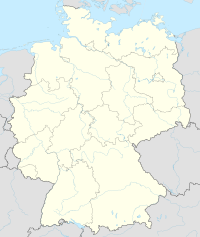
Anne of Cleves was Queen of England from 6 January to 12 July 1540 as the fourth wife of Henry VIII. Little is known about Anne before 1527, when she became betrothed to Francis, Duke of Bar, son and heir of Antoine, Duke of Lorraine, although their marriage did not proceed.
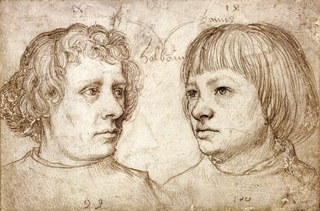
Ambrosius Holbein was a German and later a Swiss artist in painting, drawing, and printmaking. He was the elder brother, by about three years, of Hans Holbein the Younger, but he appears to have died in his mid-twenties, leaving behind only a small body of work.

Hans Holbein the Younger was a German-Swiss painter and printmaker who worked in a Northern Renaissance style, and is considered one of the greatest portraitists of the 16th century. He also produced religious art, satire, and Reformation propaganda, and he made a significant contribution to the history of book design. He is called "the Younger" to distinguish him from his father Hans Holbein the Elder, an accomplished painter of the Late Gothic school.

Elizabeth Seymour was a younger daughter of Sir John Seymour of Wulfhall, Wiltshire and Margery Wentworth. Elizabeth and her sister Jane served in the household of Anne Boleyn, the second wife of Henry VIII. The Seymours rose to prominence after the king's attention turned to Jane. In May 1536, Anne Boleyn was accused of treason and adultery, and subsequently executed. On 30 May 1536, eleven days after Anne's execution, Henry VIII and Jane were married. Elizabeth was not included in her sister's household during her brief reign, although she would serve two of Henry VIII's later wives, Anne of Cleves and Catherine Howard. Jane died 24 October 1537, twelve days after giving birth to a healthy son, Edward VI.
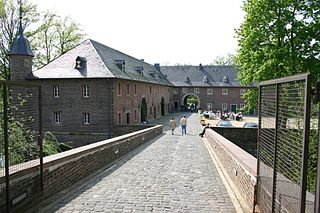
Düren is a town in North Rhine-Westphalia, Germany, between Aachen and Cologne, on the river Rur.

Frederiksborg Castle is a palatial complex in Hillerød, Denmark. It was built as a royal residence for King Christian IV of Denmark-Norway in the early 17th century, replacing an older castle acquired by Frederick II and becoming the largest Renaissance residence in Scandinavia. On three islets in the Slotssøen, it is adjoined by a large formal garden in the Baroque style.

Anna of Lorraine was a princess of the House of Lorraine. She was Princess of Orange by her first marriage to René of Châlon, and Duchess of Aarschot by her second marriage to Philippe II of Croÿ.

The German Renaissance, part of the Northern Renaissance, was a cultural and artistic movement that spread among German thinkers in the 15th and 16th centuries, which developed from the Italian Renaissance. Many areas of the arts and sciences were influenced, notably by the spread of Renaissance humanism to the various German states and principalities. There were many advances made in the fields of architecture, the arts, and the sciences. Germany produced two developments that were to dominate the 16th century all over Europe: printing and the Protestant Reformation.

The artists of the Tudor court are the painters and limners engaged by the monarchs of England's Tudor dynasty and their courtiers between 1485 and 1603, from the reign of Henry VII to the death of Elizabeth I.
Events from the year 1539 in art.

Jane Meutas was an English lady of the Queen's privy chamber who became the wife of the courtier Peter Meutas. Her name is sometimes given as Joan, and her maiden name was Astley. Her husband was knighted on 18 May 1544, when she became Lady Meutas. She is the subject of a portrait sketch by Hans Holbein the Younger which is believed to date from the 1530s and is in the Royal Collection.
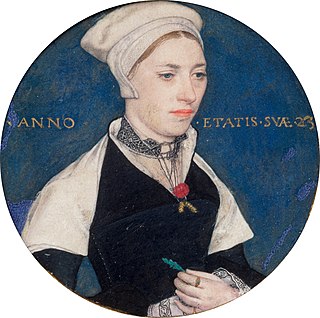
Jane Small (c. 1518–1602) was a daughter of Christopher Pemberton, a Northamptonshire gentleman. She is well known as the subject of a portrait miniature by the famous 16th-century German artist Hans Holbein the Younger, painted about 1540. Holbein was known as a painter of the English court, where his paintings included those of King Henry VIII and several of his wives.

Catherine Howard was Queen of England from July 1540 until November 1541 as the fifth wife of King Henry VIII. She was the daughter of Lord Edmund Howard and Joyce Culpeper, a cousin to Anne Boleyn, and the niece of Thomas Howard, 3rd Duke of Norfolk. Thomas Howard was a prominent politician at Henry's court. He secured her a place in the household of Henry's fourth wife, Anne of Cleves, where Howard caught the King's interest. She married him on 28 July 1540 at Oatlands Palace in Surrey, just 19 days after the annulment of his marriage to Anne. He was 49, and it is widely accepted that she was about 17 at the time of her marriage to Henry VIII.

Bartholomäus Bruyn (1493–1555), usually called Barthel Bruyn or Barthel Bruyn the Elder, was a German Renaissance painter active in Cologne. He painted altarpieces and portraits, and was Cologne's foremost portrait painter of his day.
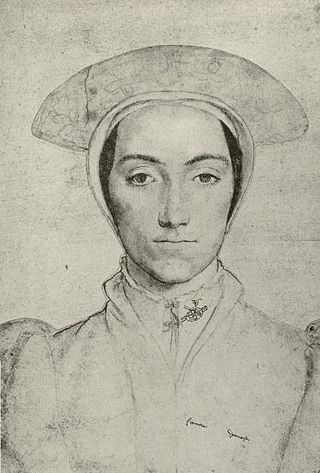
Amalia of Cleves, sometimes spelled as Amelia, was a princess of the House of La Marck. The fourth and youngest child of John III, Duke of Cleves, and his wife Maria of Jülich-Berg, Amalia was born shortly after the birth of her brother William, a future Duke.

The Basel Town Hall is a 500-year-old building dominating the Marktplatz in Basel, Switzerland.

Portrait of Thomas Cromwell is a small oil painting by the German and Swiss artist Hans Holbein the Younger, usually dated to between 1532 and 1534, when Cromwell, an English lawyer and statesman who served as chief minister to King Henry VIII of England from 1532 to 1540, was around 48 years old. It is one of two portraits Holbein painted of him; the other is a tondo from a series of medallions of Tudor courtiers.

Portrait of a Lady with a Squirrel and a Starling is an oil-on-oak portrait completed in around 1526–1528 by German Renaissance painter Hans Holbein the Younger. The painting shows a demurely dressed young woman sitting against a plain blue background and holding in her lap a squirrel on a chain eating a nut; a starling sits on a grape vine in the background with its beak pointing at her right ear. The grape, a Biblical motif, for Holbein was a symbol of abundance and wealth. The subject of this portrait is believed to be Anne Lovell, wife of Sir Francis Lovell (d. 1551), an Esquire of the Body to Henry VIII.

Portrait of a Lady, probably a Member of the Cromwell Family is an oil on panel portrait completed in around 1535–1540 by Hans Holbein the Younger now at the Toledo Museum of Art. The painting shows an elegantly but demurely dressed young woman sitting against a blue-grey background. The subject of this portrait is thought to be a member of the Cromwell family, perhaps Thomas Cromwell's daughter-in-law, Elizabeth Seymour, sister to Jane, third consort of Henry VIII.

